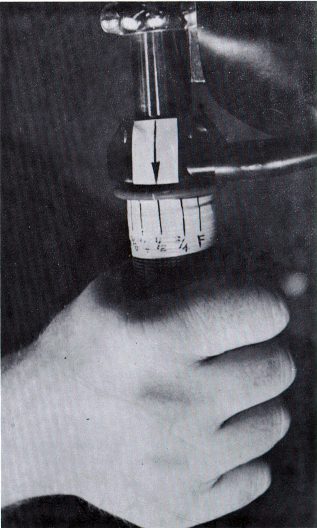
FIG. 140
Page 111
4. If the exhaust makes sounds like that of a four stroke engine, in which it only fires every other revolution, and the engine accelerates poorly, the mixture is too rich. If the exhaust emits excessive smoke, and the fuel-oil ratio is correct, the mixture is too rich. If any of these symptoms occur, remember at what throttle opening(s) they do so.
5. A convenient way to find at what throttle position you are riding is to wrap a piece of white or light colored tape approximately 1" wide around the throttle twistgrip right next to the throttle housing. Using the seam between the two halves of the housing as a reference, measure and mark the tape with lines designating 0, 1/8, 1/4, 1/2, 3/4 and full throttle. (Fig. 140) For ease of reading, you may want to use a different color line for each throttle opening. This way, you will only need to take your eyes off the road for a minimum time. Then, while riding, you can turn the throttle until the engine runs erratically, and simply glance down at the throttle to tell how far it is open.
6, ENGINE RUNS LEAN AT ALL THROTTLE OPENINGS. If the engine showed lean symptoms at all throttle openings, and assuming that all things mentioned in Section 1, Paragraph 2 of this chapter are in proper working order, the float bowl should be removed and the float checked for proper operation.
7. The float needle should be free to move up and down inside the float metering jet, and the float itself should pivot freely on the pin.
If all this is working properly, check the float level. You can do this by holding the float bowl assembly in your hand with the float facing you and the tickler button pointed directly downward. At approximately the 1:00 o'clock position, there is a small rib cast into the inside edge of the float bowl. Using the smooth end of a 1/4" drill bit or a piece of 1/4" rod, pass the rod between the small rib and the body of the float. With the float bowl still upside down and the float resting on the needle, the rod should pass between the rib and the float, touching both, but without moving the float. (Fig. 141)

FIG. 140
Page 111